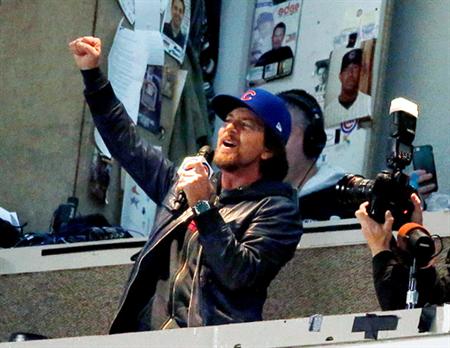Features
Pearl Jam And Chicago Cubs Combine In Concert Flick
To many fans of Pearl Jam, the band’s two-concert stand last summer at

AP Photo / Nam Y. Huh – Wolrd Series 2016 Vedder Sings
Eddie Vedder sings “Take Me Out To The Ballgame” during the seventh-inning stretch of Game 5 of the World Series at Wrigley Field in Chicago Oct. 30.
In the new documentary “Let’s Play Two,” the concerts become the soundtrack for the Chicago Cubs ending their 108-year World Series drought, the worlds of rock and sports tied together by band frontman Eddie Vedder, a lifelong Cubs fan.
Clinch’s cameras captured a dozen live Pearl Jam songs performed Aug. 20 and Aug. 22 in 2016 (including “Last Exit,” ‘‘Jeremy” and “Inside Job”) while also charting the Cubs’ electrifying World Series run that fall while also celebrating the city of Chicago. The Associated Press asked Clinch how the movie came about.
AP: This isn’t a straight-ahead concert film. It combines two different things, baseball and rock ‘n’ roll. What did you start with?
Clinch: We went there to film Pearl Jam’s two shows at Wrigley, which was incredible. The energy was great, the performances were great, and that’s what you hope for. We captured it in a way we were very happy with at the end. When that whole intense process was finished — the last note of the last show — I think we were all thinking, in the back of our minds, ‘Well, you know, we are at Wrigley Field. The Cubs are on a mad tear and Ed is a big Cubs fan. What would happen if this actually came to pass?’ I said to Eddie and Theo Epstein, the general manager of the Cubs, I said, ‘Look, if they make a run, I’m going to come back with my cameras. Do you guys mind?’ They were like, ‘No, no. Let’s see what happens.’
It’s a careful balance on film, a love letter to the Cubs and Chicago with a soundtrack by Pearl Jam. Was it hard to put together?
It was difficult. It was interesting because we were capturing hope and devotion from both sides – from the Pearl Jam fan side, from the Cub side, from the band side as well. The idea of weaving that all together was really interesting.
You have worked with the band before. Did that help you get intimate moments like a moment you captured them doing a sound check on a roof overlooking Wrigley?
My relationship with them is long and there is a trust there. I don’t think they would let just anybody up there to do it. They know that I respect them. They know I respect their guitar tech, their tour manager, their whole team. We know that they’re not in our film. We’re filming their show. And I think that’s an important thing to remember. By doing that and by always showing respect, they allow me to capture that stuff. They’re not a band that allows everybody to capture that stuff. They’re not a band that’s posting to Instagram from backstage or doing a Snapchat or something like that. They are private and they enjoy their privacy. I’m a Pearl Jam fan and I’m a music fan and what do I want to see?
How did you lay out the music? You make the songs comment on the action, as when the song “Alive” plays when the Cubs forced a Game 7, staying alive in the contest.
The set-list was a challenge. The band said, ‘It’s your film, you do the set-list.’ I was like, ‘OK.’ I was grateful to have that opportunity and I thought, ‘Well, you know what? I’m going to rough it out and then give it to them and I’m sure they’ll tell me what they want to do.’ I roughed it out and they didn’t say anything. They were like, ‘This looks good to us.’ The way they set their set-list up, they eased into it. It kind of started on a mellow tip and there was this build, build, build, and this ebb and flow, which is actually how a film should be. In a way, it was very cinematic. We wanted to keep the spirit of that set-list.
Have you ever done anything like this before?
I’ve done quite a few concert films, quite a few documentaries. I’ve never had an opportunity to mix the two. And it was a great challenge.
What would have happened if the Cubs collapsed, the season ended with failure?
You know, I don’t think the film would have been that much different. We probably would have followed the story the way that we did. The end would be different.